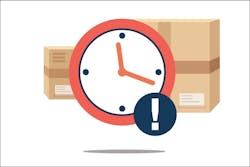David Mings tried to put on a brave face. But this was not how he envisioned taking over a parts department.
In 2015, upon his appointment as the leader of the parts department at Hardin County
Honda, Mings inherited nearly $90,000 in obsolescence.
Gulp.
“I was really nervous,” Mings recalls. “I wanted to make sure I got rid of [the parts obsolescence] and showed that the numbers were going down, and that I was meant for this job.”
His parts department in Elizabethtown, Ky. had accumulated piles of old bearings, cranks, and connecting rods from vehicles dating back to the 1970s—parts that Mings says were “collecting dust.” So, he put his head down, began taking inventory of every corner of his department, sent parts back to the manufacturer, and sold off every part he could to wholesalers.
Three years later, the parts department at Hardin County Honda is on firmer ground, with
an inventory of around $200,000 and a solid wholesaling business that recently began delivering to clients. Mings can breathe easy.
Mings, currently nearing the end of his first decade in the industry, has learned that obsolete parts (those held in inventory for roughly one year) offer zero chance for profit. Mings has also learned that it’s imperative to keep parts obsolescence as low as possible (ideally below 5 percent)—and that’s why he stores 3- to 6-month-old parts up front in his department and constantly considers the best ways to get rid of them.
Below, Mings shares further, noteworthy lessons regarding how to limit parts obsolescence.
Check Your Reports Daily.
Virtually every parts manager has encountered the scenarios Mings dealt with in 2015: special-order parts are never picked up, or, your dealership’s service or collision repair directors made parts orders and tracked them poorly. Those are scenarios that can leave disorganization—and parts obsolescence—in their wake.
But, Mings knows such scenarios can be managed by consistently checking reports pertaining to special orders, open ROs, or open counter tickets.
Additionally, he often touches base with Hardin County Honda’s controller, for example, who closely studies the dealership’s parts inventory via detailed Excel spreadsheets.
Demand Prepayment on Special-Order Parts.
There’s an easy way to avoid collecting a pile of parts in the wake of a recall. Mings was reminded of that in recent years, when he noticed how much more frequently customers pick up special-order parts when they’re forced to prepay for them.
“If you don’t get the prepayment, and then we get [the part], it could sit on the shelf,” he says. “We forget about it, they never come pick it up, and then it can just start stacking up.”
Learn Your OEM’s Return Allowance.
Recently, parts department employees have noted that it pays—literally—to learn the ins and outs of their manufacturer’s suggested stock return allowance. Mings studied those stipulations closely, and takes advantage as much as possible.
He discovered that he could save his department thousands by simply filling out the required documentation to return parts to Honda.
“Honda has an SRA (sales return allowance) allowance [in which] the more you buy from them, you get a percentage back to return,” Mings notes. “So I go through about twice per week and try to send back parts.”
Reach Out to Similar Dealers.
Like at many dealerships, Hardin County Honda utilizes parts procurement solutions like CollisionLink and RevolutionParts to help find buyers for aging parts. But Mings has discovered that it can also pay dividends to reach out to his dealership colleagues around the country when trying to unload obsolete parts.
“I’ll load parts lists up, and fax them to other Honda dealers,” he says. “I’ve gotten postcards from Honda dealers out west. It says, ‘Fax us your spreadsheet and we’ll see if we can buy anything.’ And we’ve had really good luck with them; one bought about $4,500 worth from us once.”

